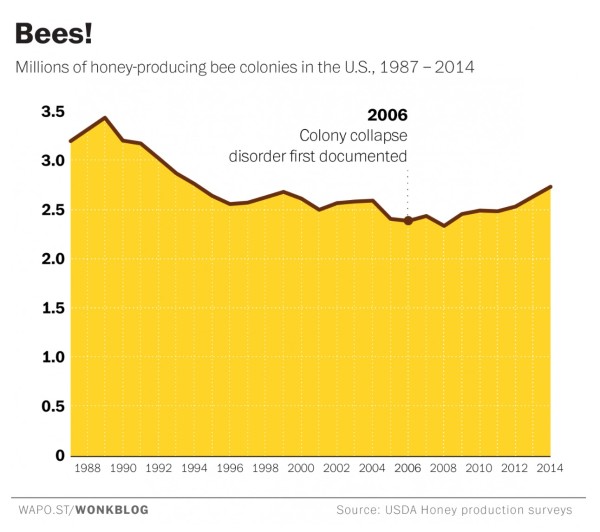We take the brief time out from the climate apocalypse in Paris—also known as “thermageddeon”—to make note of the official cancellation of the “Bee-pocalypse.” From the Washington Post:
Call off the bee-pocalypse: U.S. honeybee colonies hit a 20-year high
You’ve heard the news about honeybees. “Beepocalypse,” they’ve called it. Beemageddon. America’s honeybees are dying, putting honey production and $15 billion worth of pollinated food crops in jeopardy.
The situation has become so dire that earlier this year the White House put forth the first National Strategy to Promote the Health of Honey Bees and Other Pollinators, a 64-page policy framework for saving the nation’s bees, butterflies and other pollinating animals.
The trouble all began in 2006 or so, when beekeepers first began noticing mysterious die-offs. It was soon christened “colony collapse disorder,” and has been responsible for the loss of 20 to 40 percent of managed honeybee colonies each winter over the past decade.
I remember this well: it was all the rage a decade ago. I recall having the thought: “Gee—given that bees are so valuable, I’ll bet there’s a market for them, and a robust private sector business if scarcity is raising prices. I recall looking into this three years ago, and finding a great data series on rising prices of bees, and the way beekeepers were responding by propagating bees, but I can’t now seem to lay my hands on the charts. Anyway, the Post summarizes the logic nicely, along with this terrific chart:
As you can see, the number of honeybee colonies has actually risen since 2006, from 2.4 million to 2.7 million in 2014, according to data tracked by the USDA. The 2014 numbers, which came out earlier this year, show that the number of managed colonies — that is, commercial honey-producing bee colonies managed by human beekeepers — is now the highest it’s been in 20 years.
So if CCD is wiping out close to a third of all honeybee colonies a year, how are their numbers rising? One word: Beekeepers.
A 2012 working paper by Randal R. Tucker and Walter N. Thurman, a pair of agricultural economists, explains that seasonal die-offs have always been a part of beekeeping: they report that before CCD, American beekeepers would typically lose 14 percent of their colonies a year, on average.
So beekeepers have devised two main ways to replenish their stock. The first method involves splitting one healthy colony into two separate colonies: put half the bees into a new beehive, order them a new queen online (retail price: $25 or so), and voila: two healthy hives.
See—we didn’t need a 64-page “policy framework” from the White House after all. Now if they would just buzz off about a few other things.

Notice: All comments are subject to moderation. Our comments are intended to be a forum for civil discourse bearing on the subject under discussion. Commenters who stray beyond the bounds of civility or employ what we deem gratuitous vulgarity in a comment — including, but not limited to, “s***,” “f***,” “a*******,” or one of their many variants — will be banned without further notice in the sole discretion of the site moderator.